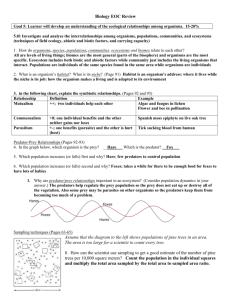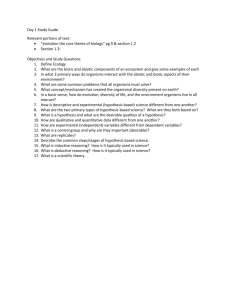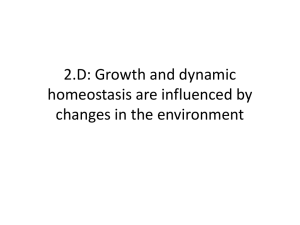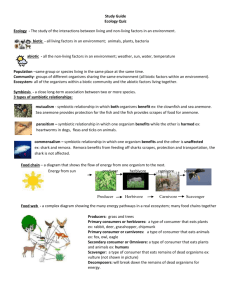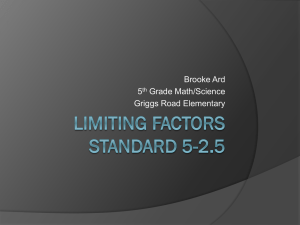4.04 Analyze and explain the interactive role of internal and external
advertisement
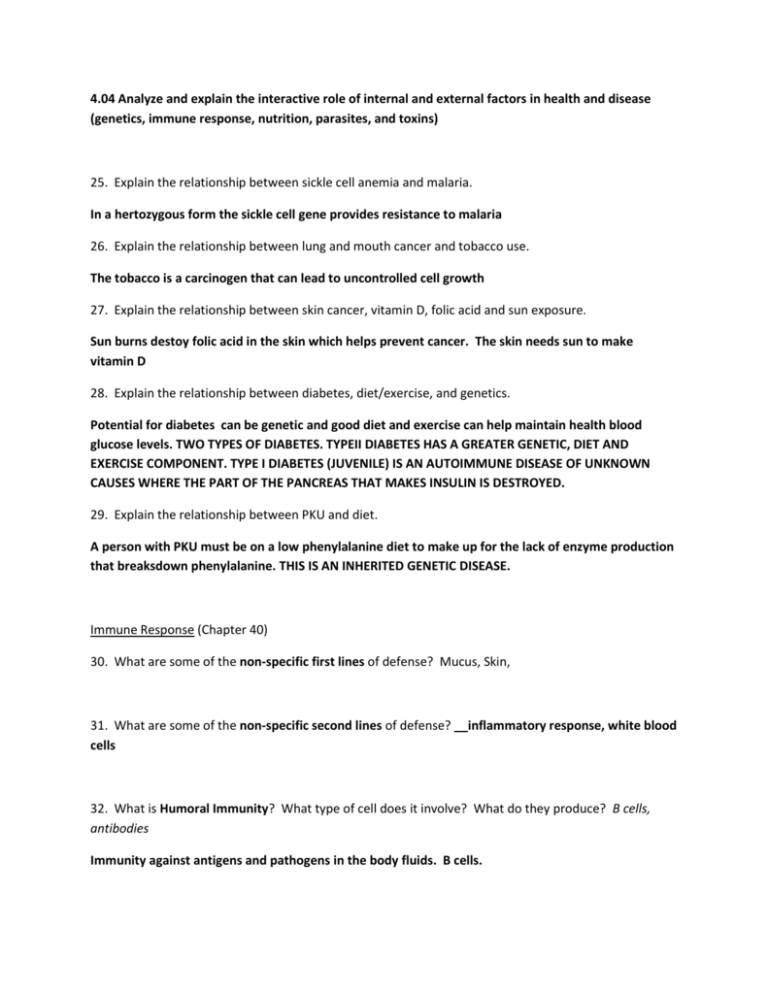
4.04 Analyze and explain the interactive role of internal and external factors in health and disease (genetics, immune response, nutrition, parasites, and toxins) 25. Explain the relationship between sickle cell anemia and malaria. In a hertozygous form the sickle cell gene provides resistance to malaria 26. Explain the relationship between lung and mouth cancer and tobacco use. The tobacco is a carcinogen that can lead to uncontrolled cell growth 27. Explain the relationship between skin cancer, vitamin D, folic acid and sun exposure. Sun burns destoy folic acid in the skin which helps prevent cancer. The skin needs sun to make vitamin D 28. Explain the relationship between diabetes, diet/exercise, and genetics. Potential for diabetes can be genetic and good diet and exercise can help maintain health blood glucose levels. TWO TYPES OF DIABETES. TYPEII DIABETES HAS A GREATER GENETIC, DIET AND EXERCISE COMPONENT. TYPE I DIABETES (JUVENILE) IS AN AUTOIMMUNE DISEASE OF UNKNOWN CAUSES WHERE THE PART OF THE PANCREAS THAT MAKES INSULIN IS DESTROYED. 29. Explain the relationship between PKU and diet. A person with PKU must be on a low phenylalanine diet to make up for the lack of enzyme production that breaksdown phenylalanine. THIS IS AN INHERITED GENETIC DISEASE. Immune Response (Chapter 40) 30. What are some of the non-specific first lines of defense? Mucus, Skin, 31. What are some of the non-specific second lines of defense? __inflammatory response, white blood cells 32. What is Humoral Immunity? What type of cell does it involve? What do they produce? B cells, antibodies Immunity against antigens and pathogens in the body fluids. B cells. 33. What do B cells produce? Plasma cells and memory B cells 34. What is happening at letter C? Antibodies are attacking the pathogens 35. What is the function of helper T-cells? They activate killer T cells and produce memory T cells 36. What is the function of killer T-cells? Track down and kill pathogens 37. What is the function of suppressor T-cells? Shut down killer T cells when the job is done 38. What kind of cells are produced at letter D that keep you from becoming re-infected? (Secondary infection?) Memory B Cells 39. What is the difference between active immunity and passive immunity? Active is the body's response to vaccines. Passive is the injection of other animals antibodies 40. Explain what vaccines do to the immune system. They induce the body's development of antibodies 41. Are antibiotics used against viruses? What is used against viruses? No, they only work against bacteria. You need anti-viral meds against viruses. Health and Nutrition 42. What type of diet contributes to optimal health? (High in what and Low in what?) High in fiber/protein, low in fat. Balanced diet. High-carbs and fruits and vegetables Low- fats oils and sweets 43. What type of diet contributes to obesity? Diabetes? (Page 1008) High in sugar (see question 42.) high in complex carbohydrates and low in saturated fats. 44. What type of diet contributes to malnutrition? A lack of vitamins and minerals 45. What happens when someone is deficient in Vitamin C? Scurvy Vitamin D? Rickets A? Vitamin 46. What are some of the concerns over skin cancer, folic acid and sun exposure? (Pages 974) same as 27 47. What are some of the concerns over lung and mouth cancer from tobacco use? (Pages 962) same as 28 Parasites (Malaria) 48. Describe the life cycle of the malarial parasite. (Page 503) What is the vector? treatments? Mosquitoes and mosquitoes control What are the symptoms? severe chills and fever What are the drugs, NO vaccine KNOWN, Environmental Toxins 49. Explain the effects on human health of: Lead: _increased blood pressure, anemia, brain and kidney damage, LOW IQ Mercury: brain damage, blindness, seizures 4.05 Analyze the broad patterns of animal behavior as adaptations to the environment. 50. What is a stimulus? What is a response? (Page 871) any kind of signal that carries information and can be detected. Response – a reaction to a stimulus 51. Why is it important that organisms are able to respond to their environment and surroundings? Allows for interaction with the environment and increased fittness. 52. What are some ways that animals communicate? (Pages 881-882) visual signals, chemical signals, sound signals, language. 53. Compare and contrast classical conditioning and operant conditioning. (Pages 874-875) classical is based on punishment and reward - Operant is based on repeated behavior. 54. What is habituation? Why is it good for the animal and evolution as a whole? The process by which animals decrease or stop response to repetitive stimulus that niether rewards or harms. Decreases use of unnecessary expense of energy. 55. What is imprinting? Why is this important? (Page 876) recognizing and following the first thing a baby sees to move. It keeps young animals close to their mothers 56. Describe insight learning and explain which type of species has this kind of behavior. (Page 875) Reasoning. The ability to apply something learned to a new situation. Comman among humans and other primates. 57. Complete the following Chart of Animal Behavior. (Chapter 34) Type of Behavior Explanation of Behavior Survival Value of Behavior Migration This is when organisms move from one place to another periodically, generally in response to temperature or food availability. 58. Which of the above behaviors are innate (or instinct)? All but those listed in 59 59. Which of the above behaviors are learned? Classical conditioningHABITUATION and trial and error Maintaining food source/ GOOD BREEDING 60. Which of the above behaviors are social? Courtship and territoriality AND SOME MIGRATION Goal 5: Learner will develop an understanding of the ecological relationships among organisms. 1520% 5.01 Investigate and analyze the interrelationships among organisms, populations, communities, and ecosystems (techniques of field ecology, abiotic and biotic factors, and carrying capacity) 1. How do organisms, species, populations, communities, ecosystems and biomes relate to each other? All are levels of living things; biomes are the most general (parts of the biosphere) and organisms are the most specific. Ecosystem includes both biotic and abiotic factors while community just includes the living organisms that interact. Populations are individuals of the same species found in the same area while organisms are individuals 2. What is an organism’s habitat? What is its niche? (Page 91) Habitat is an organism’s address: where it lives while the niche is its job: how the organism makes a living and is adapted to its environment 3. in the following chart, explain the symbiotic relationships. (Pages 92 and 93) Relationship Definition Example Mutualism ++; two individuals help each other Algae and fungus in lichen Flower and bee in pollination Commensalism +0; one individual benefits and the other Spanish moss epiphyte on live oak Parasitism neither gains nor loses tree +-; one benefits (parasite) and the other is hurt (host) Tick sucking blood from human Predator-Prey Relationships (Pages 92-93) 4. In the graph below, which organism is the prey? __Hare___ Which is the predator? __Fox___ 5. Which population increases (or falls) first and why? Hare; few predators to control population 6. Which population increases (or falls) second and why? Foxes; takes a while for there to be enough food for foxes to have lots of babies 1. Why are predator/prey relationships important in an ecosystem? (Consider population dynamics in your answer.) The predators help regulate the prey population so the prey does not eat up or destroy all of the vegetation. Also some prey may be parasites on other organisms so the predators keep them from becoming too much of a problem. Sampling techniques (Pages 63-65) Assume that the diagram to the left shows populations of pine trees in an area. The area is too large for a scientist to count every tree. 8. How can the scientist use sampling to get a good estimate of the number of pine trees per 10,000 square meters? Count the population in the individual squares and multiply the total area sampled by the total area to sampled area ratio. 9. Assume that each small plot (square) is 10 m x 10 m. Estimate the population size of the whole area. 11 trees in 12 plots: average 11 trees/12 plots = 1 tree/plot (=0.91666 no calculator on EOC!) 1 tree to 100 m squared is x to 10,000 m squared = 100 trees (91.666666 or 92 trees) 10. How could the same process (above) be used to estimate species diversity? Record the number of individuals of each species in each sample plot 11. How could the same process be used to discover changes in the environment over time? Record the number of individuals of each species in each sample plot every year, five years, or other period of time 12. What is carrying capacity? (Page 122) The number of individuals of a population and given area or environment can sustain over a period of time. (Shown by logistic or S curve) 13. What are density dependent limiting factors? What are density independent limiting factors? (Page 125/127) Dependent limiting factors are determined by the number of individuals present in the area: examples-predators would be density dependent as would disease. Independent limiting factors are not determined by the number of individuals present in an area example: temperature or pH Biotic and Abiotic Factors (Page 90) 14. List at least 3 biotic factors in an environment. Number of shade trees, disease organisms, predators, density of prey organisms, number of pollinators 15. List at least 3 abiotic factors in an environment. pH, temperature, salinity, light, rainfall, soil type 16. Give an example of how biotic & abiotic factors act together to limit population growth and affect carrying capacity. Annual rainfall can determine the biomass potential of the producers in a region, thus limiting the rate of reproduction Graph 1: Rabbits Over Time 17. What kind of growth curve is shown by the graph to the right? Logistic ; “S” curve 18. What is the carrying capacity for rabbits? 66 19. During what month were rabbits in exponential growth? May Graph 2: Mexico and US 20. In Mexico, what percentage of the population is between 0-4 years of age? 16% 21. In the US? 7% 22. Which population is growing the fastest? Mexico 23. Which age group has the smallest number in both countries? Mexico 80+; US 75-80 Chart 3: Trapping Geese Year Geese Number with Trapped Mark 1980 10 1 (10x10)/1=100 1981 15 1 (15x10)/1=150 1982 12 1 (12x10)/1=120 1983 8 0 n/a 1984 5 2 (5x10)/2=25 1985 10 1 (10x10)/1=100 In order to estimate the population of geese in Northern Wisconsin, ecologists marked 10 geese and then released them back into the population. Over a 6 year period, geese were trapped and their numbers recorded. 24. Use the formula to calculate the estimated number of geese in the area studied? (Page 65) This technique is called ____mark___ & _recapture_______ 25. Supposing more of the geese found in the trap had the mark, would the estimated number of geese in the area be greater or lesser? Lesser 5.02 Analyze the flow of energy and the cycling of matter in the ecosystem (relationship of the carbon cycle to photosynthesis and respiration and trophic levels – direction and efficiency of energy transfer). Carbon cycle Diagram (Page 77) 26. Which process(es) put carbon dioxide into the atmosphere? _Respiration; 27. Which process(es) take carbon dioxide out of the atmosphere? __Photosynthesis_______________________________________ 28. How does photosynthesis and cell respiration relate to Carbon cycle? Photosynthesis removes carbon dioxide from the air and respiration adds it to the air. The products of one are the reactants of the other. 29. Explain the Greenhouse Effect in relationship to carbon dioxide in the atmosphere. Increase of carbon dioxide prevents infrared light (heat) from leaving the atmosphere. This raises the earth’s temperature just like glass in a greenhouse traps heat and keeps the greenhouse warm. 30. What effect might increased atmospheric carbon dioxide have on the environment? Increased trapping of heat and thus higher temperatures. Some plant species may grow faster with more carbon dioxide. 31. How do bacteria play a role in the Carbon Cycle? Bacteria can do all parts of the carbon cycle: photosynthesis, respiration and decomposition. Primary and Secondary Succession (Pages 94 & 95) 32. What is Primary Succession? Process where the species present change Starting with a new community with no soil: bare rock, lava or small pond and going to climax 33. What is Secondary Succession? Process where the species present change Starting with some soil (and underground seeds, organisms and bacteria) and going to climax 34. What is a Climax Community? The stable community at the end of succession typical of its biome. Beech-Maple forest or tropical savanna 35. What is a pioneer species? How are they important? Species which show up during early succession. They tend to travel easily (wind) and grow quickly. They protect the soil and provide shade so climax species can gain a foothold. Food Webs (Pages 69-70) 36. What are the producers in this food web? Blossoms, nuts, bark, leaves 37. What are the primary consumers (herbivores) in this food web? Bees, mice, deer, rabbit, insects 38. What are the secondary consumers in this food web? Bear, wolf, fox, toad, skunk, birds 39. What are the highest level consumers in this food web? Bear 40. How does energy move through a food web? 10% moves through each tropic level 41. How does matter move through a food web? Same as 40 42. What is a food chain? Give an example of one from this food web. A series of steps in which organisms transfer energy by eating and being eaten 43. Create an energy pyramid from the food chain: Leavesinsectsbirdsred foxbear 44. Where is the most energy in this pyramid? Bottom: plants, producers 45. Where is the least energy in this pyramid? Top: bear, 4th level consumer 46. What happens to energy as it moves through the food chain/web? Most is “lost” as waste heat about 10% at each level is converted into biomass or available energy (food!) 47. Assume there are 10,000 kcal of energy in the leaves? Estimate the amount of energy in each of the other levels of the energy pyramid.10, 000; 1000; 100; 10; 1; 0.1 kcal 48. What percent of energy is lost? ___90_____% Remember these numbers vary! 49. How much is passed on? __10___% 50. What is the ultimate source of energy for this food web? The nuclear fusion in the sun! 51. What are the other two types of pyramids? Explain. Numbers (show number of individuals at each level) and biomass (total dry weight of all individuals at each level.) 52. What is a biome? What are the two limiting factors in a biome? (Page 64) Biome is a large area with similar type of vegetation and similar climate. The two main limiting factors are temperature (especially does it freeze) and precipitation. 5.03 Assess human population and its impact on local ecosystems and global environments (historic and potential changes in population, factors associated with those changes, climate change, resource use, and sustainable practices/stewardship). 53. What are the effects of bioaccumulation (biomagnifications) of pesticides on a food web? At bottom of food web poison is at low concentration and may cause no damage but as it builds up in the higher level organisms it may make top level consumers sick; sterile or even dead. 54. Why do some species become resistant to pesticides? A random mutation occurs or a virus transfers a gene to a different species. Individuals with this mutation are not killed and pass on the resistant gene to their offspring. 55. What are some pros and the cons of biocontrols as alternatives to pesticides? Less harmful to the environment; only kill the targeted pest; since are living species once introduced they reproduce themselves Con: takes time to discover the biocontrol; some take longer to take effect 56. Explain the effect each of the following may have on the environment. Factor Effect on Environment Population Size Contributes to the consumption of resources and destruction of ecosystem Population Density Effects intraspecies competition, overconsumption, etc. Resource Use Limits population size Acid Rain Destroys producers, changes pH in waters and soils, harms biotic factors of the ecosystem Habitat Destruction Destroys natural resources, increases rate of erosion, decreases biodiversity. Introduced non-native species Reproduces rapidly, due to having no predators evolved in new location. Can Pesticide use Kills off primary consumers in the food chain; poisons ground water. Deforestation Cuts down trees….. nuff said 57. What is the role of carbon emissions and other emissions as causes of global warming? Carbon dioxide is a greenhouse gas that can increase global warming. Methane produced by bacteria in livestock and from land fills is another greenhouse gas. 58. What are some possible effects of global warming? Spread of tropical diseases to temperate zones; extinction of species; more variation in weather; erosion of beaches; rise of sea level; decrease crop yield; melting of permafrost; open arctic ocean; longer growing periods 59. What are some ways that carbon production can be decreased? Plant more trees/ reduce deforestation. Use less fossil fuels. See number 61. 60. What effect do volcanoes have on the atmosphere? Release of ash, particulates and sulfur dioxide can reduce the light the hits the earth surface and make the earth colder. Release of large amounts of methane and carbon dioxide can trap heat and warm the atmosphere. Also make great colorful sunsets! 61. What are some examples of sustainable practices and stewardship that can protect the environment? Reduce, recycle, reuse! Use renewable energy resources. Create green buffers near streams. Conserve energy. Use public transportation. Use chemicals and materials that don’t create dangerous wastes. 62. What is an invasive or non-native species? (Page 153) How can they cause negative effects on an ecosystem? (Cane Toads!) Non-native is a species from some other geographic location. Invasive is a species that lacks natural biotic or abiotic factors that can control the population. Problems: cause native species to go extinct; damage crops; carry disease; damage landscaping or property Human Population Growth (Pages 129-132) 63. Compare and contrast: Linear Growth, Logistic Growth, and Exponential Growth. (Pages 121-122) Linear: y=mx + b growth occurs at a steady rate Logistic: “S” curve- starts off as exponential and then levels to zero growth (hopefully at the carrying capacity) What type of growth is related to human population? Exponential 64. How did the rise of human agriculture create a significant impact on the Earth? (Pages 140-149) What kind of technology was used to feed the growing human population? Agriculture allowed the human population to increase. Many natural ecosystems were destroyed and species became extinct to create farm land. Pesticides entered the food chain and fertilizers and soil erosion damaged aquatic systems. The Green Revolution: new varieties of crops with better yield but need more pesticides, irrigation and fertilizer. More recently genetically engineered crops that are resistant to disease or pesticides or have higher yield. 65. What is the effect of resources (which are limited) on unlimited human population growth? Population may grow faster than food supplies or resources for fuel and industry. When resources become more scarce more people may starve, have more diseases or go to war over resources. 66. What is the demographic transition model? (Page 130) Human societies go from high birth rate and high death rate to then low death rate but high birth rate and finally to low birth and low death rate to reach ZPG: zero population growth (stable population) 67. The graph to the left shows the growth of the human population From 1 A.D. to 2000 A.D. Describe what you see has happened. It shows a rapid increase due to exponential growth. In the last hundred years population has doubled several times. 68. What factors influence human birth and death rates? Medical care, access to food, age of pregnancy, access to education and birth control, disease organisms, pollution, war, and many others 69. Who was Thomas Malthus? What did he say were the controls on human population growth? He was an economist and a philosopher. He stated that since population increased geometrically (exponentially) while food only increased arithmetically (linearly) people would starve unless they some how limited the number of children they would have. 70. Predict what will happen to population growth in the future and explain your reasoning. 3 possibilities: It will continue to increase. It will stabilize. It will decline. Give any logical reasons why.
